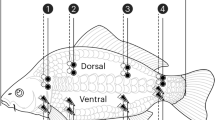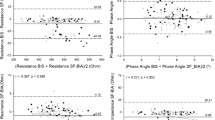Abstract
The objective of this study was to evaluate the accuracy of independent hydric data for the quantification of total body water (V t), extracellular water (V e) and intracellular water (V i), obtained by a multifrequency impedancemeter Z-Métrix® (ZM), in standing and lying position, with respect to the Xitron reference. In a second step, the aim was to consider whether it is possible to quantify daily hydration. The average repeatability error of the ZM impedancemeter is less than 0.5 %. For total body water (V t), we note a low R 2 dispersion with an average of 0.9 for men and 0.6 for women. The estimation of extracellular water is equivalent to a maximum error of 3.1 % in standing position for women against 2.97 % for men in the same position. The estimation of the total body water by direct measurement and by summing the volumes of extracellular and intracellular water obtained by the Z-Metrix® shows very low dispersions with R 2 = 0.89 and average error from 1.3 % for healthy women in lying position to 3.9 % for healthy women in standing position. Finally, despite the impact of events on the daily measurements, it is viable to track a subject’s overall hydration.


















Similar content being viewed by others
References
Bland J, Altmann DG (1996) Statistical methods for assessing agreement between two methods of clinical measurements. Lancet 1:307–313
De Lorenzo A, Andreoli A, Matthie JR, Withers P (1997) Predicting body cell mass with bio-impedance by using theoretical methods: a technological review. J Appl Physiol 82:1542–1558
Ellis KJ, Wong WW (1998) Human hydrometry comparison of multifrequency bioelectrical impedance with H2O and bromine dilution. J Appl Physiol 85:1056–1062
Genton L, Hans D, Kyle UG, Pichard C (2002) Dual energy X-ray absorptiometry and body composition: differences between devices and comparison with reference methods. Nutrition 18:66–70
Grimnes S, Martinsen OG (2005) Cole electrical impedance model-A critique and an alternative. IEEE Trans Biomed Eng 52(1):132–135
Jaffrin MY, Fenech M, Moreno MV, Kieffer R (2006) Total body water measurements by a modification of the bioimpedance spectroscopy method. Med Biol Eng Comput 44:873–882
Lazzer S, Boirie Y, Meyer M, Vermorel M (2003) Evaluation of two foot-to-foot bioelectric impedance analyzers to assess body composition in overweight and obese adolescents. Br J Nutr 90:987–992
Matthie J (2005) Second generation mixture theory equation for estimating intracellular water using bioimpedance spectroscopy. J Appl Physiol 99:780–781
Moissl UM, Wabel P, Chamney PW, Bosaeus I, Levin NW, Bosy-Westphal A, Korth O, Muller MJ, Ellegard L, Malmros V, Kaitwatcharachai C, Kuhlmann MK, Zhu F, Fuller NJ (2006) Body fluid volume determination via body composition spectroscopy in health and disease. Physiol Meas 27:921–933
Moreno M-V, Ribbe E, Rebeyrol J, Vannicatte A, Krief L Evaluation of a multifrequency impedancemeter by biphotonic Densitometry, measuring independent tissue indices, in supine and standing position. Comparison with skin folds. (Under Press, Gazetta Medica Italiana)
Moreno M-V, Djeddi D, Jaffrin MY (2008) Assessment of body composition in adolescent subjects with anorexia nervosa by bioimpedance. Med Eng Phys 30(6):783–791
Nunez C, Gallagher D, Visser M, Pi-Sunyer FX, Wang Z, Heymsfield SB (1997) Bioimpedance analysis: evaluation of leg-to-leg system based on pressure contact foot-pad electrodes. Med Sci Sports Exerc 29:524–531
Swartz AM, Evans MJ, King GA, Thompson DL (2002) Evaluation of foot-to-foot bioelectrical impedance analyzer in highly active and less active young men. Br J Nutr 88:205–210
Utter AC, Nieman DC, Ward AN, Butterworth DE (1999) Use of leg-to-leg bioelectrical impedance method in assessing body-composition change in obese women. Am J Clin Nutr 6:603–607
Acknowledgments
We, the authors, thank Mr. Jaffrin for lending us the Xitron instrument.
Author information
Authors and Affiliations
Corresponding author
Rights and permissions
About this article
Cite this article
Moreno, MV., Ribbe-Cornet, E., Rebeyrol, J. et al. Evaluation of a new impedancemeter to independently measure extracellular, intracellular and total body water volumes: application to the measurement of hydration. Med Biol Eng Comput 53, 989–999 (2015). https://doi.org/10.1007/s11517-015-1305-8
Received:
Accepted:
Published:
Issue Date:
DOI: https://doi.org/10.1007/s11517-015-1305-8




